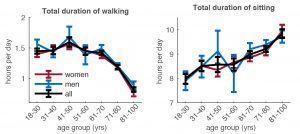Regular physical activity is important for our health and well-being. Recent evidence suggests that independent of being physically active, limiting the duration of sedentary behavior, such as sitting or lying down, is important to reduce the risk for cardiovascular disease, diabetes, cancer and all-cause mortality (Biswas et al. 2015).
Advances in wearable sensors provide a unique opportunity to accurately monitor physical activity and sedentary behaviour in daily life. These activity monitors have the potential to be the new default for quantifying physical activity and sedentary behavior in clinical settings, but their uptake is hampered by a lack of reference values.
The World Health Organization’s recommendation for physical activity is to accumulate at least 150 minutes of moderate-intensity physical activity, 75 minutes of vigorous-intensity physical activity, or an equivalent combination of the two, each week (WHO 2010). Moderate-intensity physical activity requires a moderate amount of effort and noticeably accelerates the heart rate, such as during brisk walking or doing housework. Vigorous-intensity physical activity requires a large amount of effort and causes rapid breathing and a substantial increase in heart rate, such as during walking up a hill or participating in sports.
When comparing activity monitor data to the WHO guidelines, we noted 289 out of 294 people aged 65 and over walked on average 1.3 hours each day and would thus be considered physically active (van Schooten et al. 2016). However, a recent study on global activity levels using self-reported data (Hallal et al. 2012) suggests that 31% of adults, and 40-60% of people aged 60 and over, are physically inactive. This disparity in findings between data from activity monitors and self-reported data is likely due to the fact that activity monitors measure all activities, while self-reported data are affected by recall bias. This suggests that reference data from activity monitors are essential for the development of physical activity guidelines and personalized advice.
In our recent study (van Schooten et al. 2018), our aim was to provide reference data of the habitual durations of physical activity and sedentary behavior obtained through an activity monitor for people of different ages. This study was performed in the Netherlands, where we asked 762 people between the ages of 18 and 97 to wear an activity monitor for a week. The activity monitor provided objective information about the time someone spent cycling, walking, standing, sitting and lying. We compared the duration and intensities of these activities between people grouped by age and gender.
WHAT DID WE FIND?
We found that intensities and the durations of cycling, standing and walking were stable until the fifth decade, after which they decreased (see Figure for total duration of walking). The intensity of movements showed the most pronounced differences, with lower values in people aged 51 and over (from 0.04 m/s2 in young adults to 0.02 m/s2 in adults over 81). Daily cycling duration was lower in people aged 71 and over (from 15 to 8 minutes). This pattern was similar for total duration of walking, number of walking periods and maximum walking period duration (from 1.4 to 0.8 hours of walking), but we observed more periods of walking in people aged 41 to 50 compared to those aged 31 to 40. Daily standing duration was higher in people aged 41 and over (from 2.8 to 3.4 hours), and again lower in people aged 71 and over (from 3.4 to 2.6 hours).
SIGNIFICANCE AND IMPLICATIONS
Our data on age- and gender-specific physical activity and sedentary behaviour can be used as references in clinical settings. Furthermore, our observation that physical activity starts to decline around age 50, while physical decline generally onsets later, suggests that activity promotion programs in this age group could be beneficial to prevent deconditioning and support healthy ageing. These physical activity programs should also consider gender-specific approaches as women exhibited more and longer episodes of physical inactivity and sedentary behaviour.
Despite the importance of physical activity, many people struggle to be sufficiently active. On average, people spend between 0.8 and 1.4 hours walking per day, accumulated in walks with a maximum duration of 2.6 to 6.2 min each. Most physical activity guidelines recommend a minimum activity duration of 10 min for aerobic activities, such as walking, to be considered to contribute to their achievement. Since wearable sensors detect short stops (e.g. stopping to cross the street), which would otherwise be unreported, updates to physical activity guidelines are required to match this increased resolution.
PUBLICATION REFERENCE
van Schooten KS, van Dieen JH, Pijnappels M, Maier AB, van‘t Hul AJ, Niessen M, van Lummel RC. The association between age and accelerometry-derived types of habitual daily activity: an observational study over the adult life span in the Netherlands. BMC Public Health 18: 824, 2018.
If you cannot access the paper, please click here to request a copy.
KEY REFERENCES
Biswas A, Oh PI, Faulkner GE, Bajaj RR, Silver MA, Mitchell MS, Alter DA. Sedentary time and its association with risk for disease incidence, mortality, and hospitalization in adults: a systematic review and meta-analysis. Ann Intern Med 162: 123-132, 2015.
Hallal PC, Andersen LB, Bull FC, Guthold R, Haskell W, Ekelund U, Lancet Physical Activity Series Working Group. Global physical activity levels: surveillance progress, pitfalls, and prospects. Lancet 380: 247-257, 2012.
World Health Organization. Global recommendations on physical activity for health. 2010.
Van Schooten KS, Pijnappels M, Rispens SM, Elders PJ, Lips P, Daffertshofer A, Van Dieen JH. Daily-life gait quality as predictor of falls in older people: a 1-year prospective cohort study. PLoS one 11: e0158623, 2016.
AUTHOR BIO
 Dr Kim van Schooten is a Postdoctoral Fellow at NeuRA and a Conjoint Senior Lecturer at University of the New South Wales. Her research seeks to understand why balance and mobility decline with ageing and how we can counter these declines. You can learn more about Kim and her research here or follow her on twitter @KimvanSchooten.
Dr Kim van Schooten is a Postdoctoral Fellow at NeuRA and a Conjoint Senior Lecturer at University of the New South Wales. Her research seeks to understand why balance and mobility decline with ageing and how we can counter these declines. You can learn more about Kim and her research here or follow her on twitter @KimvanSchooten.

